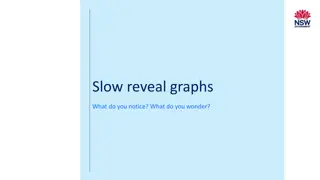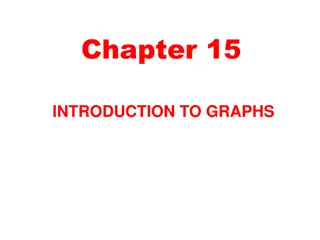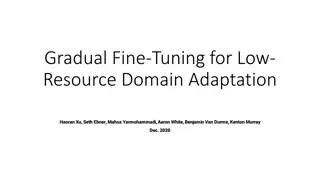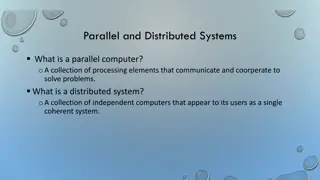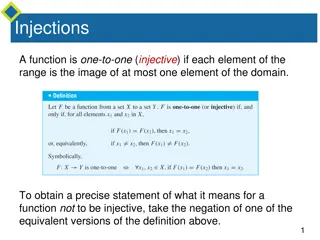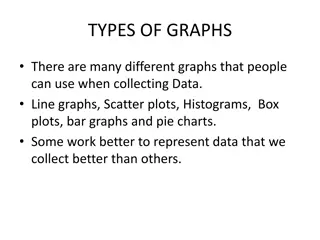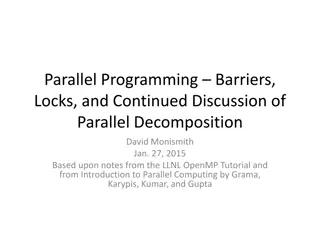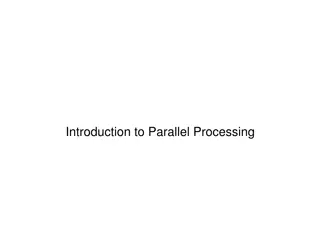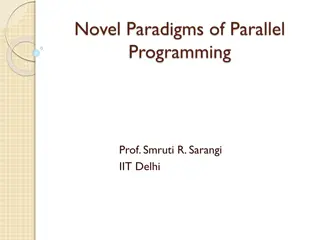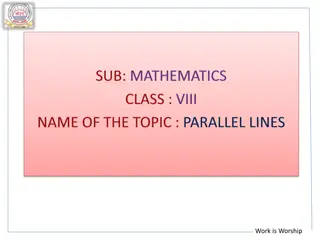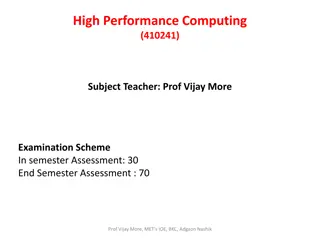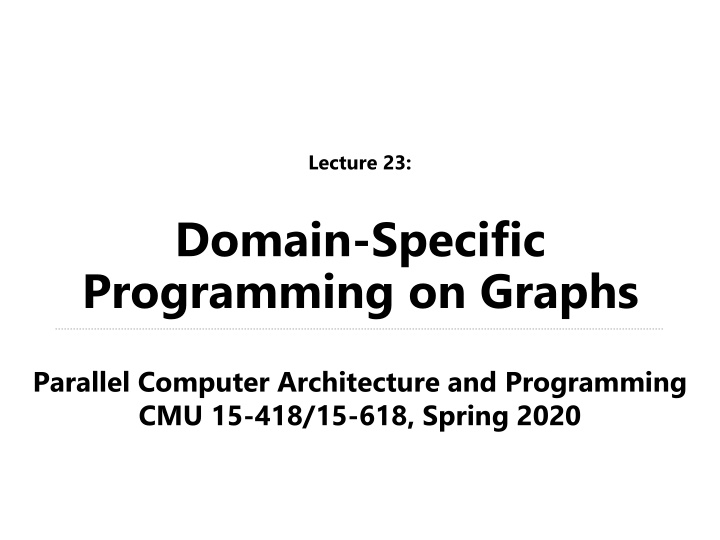
Domain-Specific Programming on Graphs in Parallel Computing
Today's topic dives into analyzing big graphs, essential in various applications like web search results and anomaly detection. The lecture emphasizes the importance of domain-specific programming systems for efficient parallel processing on modern computer architectures.
Download Presentation

Please find below an Image/Link to download the presentation.
The content on the website is provided AS IS for your information and personal use only. It may not be sold, licensed, or shared on other websites without obtaining consent from the author. If you encounter any issues during the download, it is possible that the publisher has removed the file from their server.
You are allowed to download the files provided on this website for personal or commercial use, subject to the condition that they are used lawfully. All files are the property of their respective owners.
The content on the website is provided AS IS for your information and personal use only. It may not be sold, licensed, or shared on other websites without obtaining consent from the author.
E N D
Presentation Transcript
Lecture 23: Domain-Specific Programming on Graphs Parallel Computer Architecture and Programming CMU 15-418/15-618, Spring 2020
Last time: Increasing acceptance of domain- specific programming systems Challenge to programmers: modern computers are parallel, heterogeneous machines - (Architects striving for high area and power efficiency) Programming systems trend: give up generality in what types of programs can be expressed in exchange for achieving high productivity and high performance Performance portability is a key goal: programs should execute efficiently on a variety of parallel platforms - Good implementations of same program for different systems required different data structures, algorithms, and approaches to parallelization not just differences in low-level code generation (e.g., not just a matter of generating SSE vs. AVX vs ARM Neon vs. NVIDIA PTX instructions) CMU 15-418/618, Spring 2020
Todays topic: analyzing big graphs Many modern applications: - Web search results, recommender systems, influence determination, advertising, anomaly detection, etc. Public dataset examples: Twitter social graph, Wikipedia term occurrences, IMDB actors, Netflix, Amazon communities, G+ Good source of public graphs: https://snap.stanford.edu/data/ (Jure Leskovec, CMU PhD, 2008) CMU 15-418/618, Spring 2020
Thought experiment: if we wanted to design a programming system for computing on graphs, where might we begin? What abstractions do we need? CMU 15-418/618, Spring 2020
Whenever Im trying to assess the importance of a new programming system, I ask two questions: What tasks/problems does the system take off the hands of the programmer? (are these problems challenging or tedious enough that I feel the system is adding sufficient value for me to want to use it?) What problems does the system leave as the responsibility for the programmer? (likely because the programmer is better at these tasks) Halide (recall last class): Programmer s responsibility: Liszt (recall last class): Programmer s responsibility: - Describing image processing algorithm as pipeline of operations on images - Describing the schedule for executing the pipeline (e.g., block this loop, parallelize this loop , fuse these stages ) - Describe mesh connectivity and fields defined on mesh - Describe operations on mesh structure and fields Liszt system s responsibility: - Parallelize operations without violating dependencies or creating data races (uses different algorithms to parallelize application on different platforms) - Choose graph data structure / layout, partition graph across parallel machine, manage low-level communication (MPI send), allocate ghost cells, etc. Halide system s responsibility: - Implementing the schedule using mechanisms available on the target machine (spawning pthreads, allocating temp buffers, emitting vector instructions, loop indexing code) CMU 15-418/618, Spring 2020 A good exercise: carry out this evaluation for another programming system: like OpenGL, SQL, MapReduce, etc.
Programming system design questions: What are the fundamental operations we want to be easy to express and efficient to execute? What are the key optimizations performed by the best implementations of these operations? - high-level abstractions should not prevent these - maybe even allow system to perform them for the application CMU 15-418/618, Spring 2020
Example graph computation: Page Rank Page Rank: iterative graph algorithm Devised by Larry Page & Sergey Brinn, 1996 Graph nodes = web pages Graph edges = links between pages discount Weighted combination of rank of pages that link to it Rank of page i CMU 15-418/618, Spring 2020
GraphLab A system for describing iterative computations on graphs History: - 2009 Prof Carlos Guestrin at CMU, then at U Washington - 2013 Commercialized as Turi - 2016 Acquired by Apple Implemented as a C++ runtime Runs on shared memory machines or distributed across clusters - GraphLab runtime takes responsibility for scheduling work in parallel, partitioning graphs across clusters of machines, communication between master, etc. CMU 15-418/618, Spring 2020
GraphLab programs: state The graph: G = (V, E) - Application defines data blocks on each vertex and directed edge - Dv = data associated with vertex v - Du v = data associated with directed edge u v Read-only global data - Can think of this as per-graph data, rather than per vertex or per-edge data) Notice: I always first describe program state And then describe what operations are available to manipulate this state CMU 15-418/618, Spring 2020
GraphLab operations: the vertex program Defines per-vertex operations on the vertex s local neighborhood Neighborhood (aka scope ) of vertex: - The current vertex - Adjacent edges - Adjacent vertices current vertex = vertex or edge data in scope of red vertex (graph data that can be accessed when executing a vertex program at the current (red) vertex) CMU 15-418/618, Spring 2020
Simple example: PageRank * PageRank_vertex_program(vertex i) { // (Gather phase) compute the sum of my neighbors rank double sum = 0; foreach(vertex j : in_neighbors(i)) { sum = sum + j.rank / num_out_neighbors(j); } // (Apply phase) Update my rank (i) i.rank = (1-0.85)/num_graph_vertices() + 0.85*sum; (Shown for ? = 0.85) } Programming in GraphLab amounts to defining how to update graph state at each vertex. The system takes responsibility for scheduling and parallelization. * This is made up syntax for slide simplicity: actual syntax is C++, as we ll see on the next slide CMU 15-418/618, Spring 2020
GraphLab: data access The application s vertex program executes per-vertex The vertex program defines: - What adjacent edges are inputs to the computation - What computation to perform per edge - How to update the vertex s value - What adjacent edges are modified by the computation - How to update these output edge values Note how GraphLab requires the program to tell it all data that will be accessed, and whether it is read or write access CMU 15-418/618, Spring 2020
GraphLab-generated vertex program (C++ code) struct web_page { std::string pagename; double web_page(): pagerank(0.0) { } } pagerank; Graph has record of type web_page per vertex, and no data on edges typedef graphlab::distributed_graph<web_page, graphlab::empty> graph_type; class pagerank_program: public graphlab::ivertex_program<graph_type, double>, public graphlab::IS_POD_TYPE { public: // we are going to gather on all the in-edges edge_dir_type gather_edges(icontext_type& context, Define edges to gather over in gather phase const vertex_type& vertex) const { return graphlab::IN_EDGES; } Compute value to accumulate for each edge // for each in-edge gather the weighted sum of the edge. double gather(icontext_type& context, const vertex_type& vertex, edge_type& edge) const { return edge.source().data().pagerank / edge.source().num_out_edges(); } Update vertex rank // Use the total rank of adjacent pages to update this page void apply(icontext_type& context, vertex_type& vertex, const gather_type& total) { double newval = total * 0.85 + 0.15; vertex.data().pagerank = newval; } PageRank example performs no scatter // No scatter needed. Return NO_EDGES edge_dir_type scatter_edges(icontext_type& context, const vertex_type& vertex) const { return graphlab::NO_EDGES; CMU 15-418/618, Spring 2020 } };
Running the program graphlab::omni_engine<pagerank_program> engine(dc, graph, "sync"); engine.signal_all(); engine.start(); GraphLab runtime provides engines that manage scheduling of vertex programs engine.signal_all() marks all vertices for execution You can think of the GraphLab runtime as a work queue scheduler. And invoking a vertex program on a vertex as a task that is placed in the work queue. So it s reasonable to read the code above as: place all vertices into the work queue Or as: foreach vertex run the vertex program. CMU 15-418/618, Spring 2020
Vertex signaling: GraphLabs mechanism for generating new work Iterate update of all R[i] s 10 times Uses generic signal primitive (could also wrap code on previous slide in a for loop) struct web_page { std::string pagename; double int counter; web_page(): pagerank(0.0),counter(0) { } } Per-vertex counter pagerank; // Use the total rank of adjacent pages to update this page void apply(icontext_type& context, vertex_type& vertex, const gather_type& total) { double newval = total * 0.85 + 0.15; vertex.data().pagerank = newval; vertex.data().counter++; if (vertex.data().counter < 10) vertex.signal(); } If counter < 10, signal to scheduler to run the vertex program on the vertex again at some point in the future CMU 15-418/618, Spring 2020
Signal: general primitive for scheduling work Parts of graph may converge at different rates (iterate PageRank until convergence, but only for vertices that need it) class pagerank_program: public graphlab::ivertex_program<graph_type, double>, public graphlab::IS_POD_TYPE { Private variable set during apply phase, used during scatter phase private: bool perform_scatter; public: // Use the total rank of adjacent pages to update this page void apply(icontext_type& context, vertex_type& vertex, const gather_type& total) { double newval = total * 0.85 + 0.15; double oldval = vertex.data().pagerank; vertex.data().pagerank = newval; perform_scatter = (std::fabs(oldval - newval) > 1E-3); } Check for convergence // Scatter now needed if algorithm has not converged edge_dir_type scatter_edges(icontext_type& context, const vertex_type& vertex) const { if (perform_scatter) return graphlab::OUT_EDGES; else return graphlab::NO_EDGES; } Schedule update of neighbor vertices // Make sure surrounding vertices are scheduled void scatter(icontext_type& context, const vertex_type& vertex, edge_type& edge) const { context.signal(edge.target()); } CMU 15-418/618, Spring 2020 };
Synchronizing parallel execution Local neighborhood of vertex (vertex s scope ) can be read and written to by a vertex program Programs specify what granularity of atomicity ( consistency ) they want GraphLab runtime to provide: this determines amount of available parallelism - Full consistency : implementation ensures no other execution reads or writes to data in scope of v when vertex program for v is running. - Edge consistency : no other execution reads or writes any data in v or in edges adjacent to v - Vertex consistency : no other execution reads or writes to data in v ... current vertex = vertex or edge data in scope of red vertex CMU 15-418/618, Spring 2020
GraphLab: job scheduling order GraphLab implements several work scheduling policies - Synchronous: update all scheduled vertices simultaneously (vertex programs observe no updates from programs run on other vertices in same round ) Graph (stored in data structure A) Updated graph (stored in data structure B) Updated graph (stored in data structure A) Run vertex programs for all scheduled vertices. (output to copy of graph structure) Run vertex programs for all scheduled vertices. (output to copy of graph structure) CMU 15-418/618, Spring 2020
GraphLab: job scheduling order GraphLab implements several work scheduling policies - Synchronous: update all vertices simultaneously (vertex programs observe no updates from programs run on other vertices in same round ) - Round-robin: vertex programs observe most recent updates - Graph coloring: Avoid simultaneous updates by adjacent vertices - Dynamic: based on new work created by signal - Several implementations: fifo, priority-based, splash ... Application developer has flexibility for choosing consistency guarantee and scheduling policy - Implication: choice of schedule impacts program s correctness/output - Our opinion: this seems like a weird design at first glance, but this is common (and necessary) in the design of efficient graph algorithms CMU 15-418/618, Spring 2020
Summary: GraphLab concepts Program state: data on graph vertices and edges + globals Operations: per-vertex update programs and global reduction functions (reductions not discussed today) - Simple, intuitive description of work (follows mathematical formulation) - Graph restricts data access in vertex program to local neighborhood - Asynchronous execution model: application creates work dynamically by signaling vertices (enable lazy execution, work efficiency on real graphs) Choice of scheduler and consistency implementation - In this domain, the order in which nodes are processed can be critical property for both performance and quality of result - Application responsible for choosing right scheduler for its needs CMU 15-418/618, Spring 2020
Elements of good domain-specific programming system design CMU 15-418/618, Spring 2020
#1: good systems identify the most important cases, and provide most benefit in these situations Structure of code should mimic natural structure of problems in the domain - e.g., graph processing algorithms are designed in terms of per-vertex operations Efficient expression: common operations are easy and intuitive to express Efficient implementation: the most important optimizations in the domain are performed by the system for the programmer - Our experience: a parallel programming system with convenient abstractions that precludes best-known implementation strategies will almost always fail CMU 15-418/618, Spring 2020
#2: good systems are usually simple systems They have a small number of key primitives and operations - GraphLab: run computation per vertex, trigger new work by signaling - But GraphLab s scheduling design gets messy - Halide: only a few scheduling primitives - Hadoop: map + reduce Allows compiler/runtime to focus on optimizing these primitives - Provide parallel implementations, utilize appropriate hardware Common question that good architects ask: do we really need that? Or can we reuse an existing primitive? - For every domain-specific primitive in the system: there better be a strong performance or expressivity justification for its existence CMU 15-418/618, Spring 2020
#3: good primitives compose Composition of primitives allows for wide application scope, even if scope remains limited to a domain - e.g., frameworks discussed today support a wide variety of graph algorithms Composition often allows for generalizable optimization Sign of a good design: - System ultimately is used for applications original designers never anticipated Sign that a new feature should not be added (or added in a better way): - The new feature does not compose with all existing features in the system CMU 15-418/618, Spring 2020
Optimizing graph computations (now we are talking about implementation) CMU 15-418/618, Spring 2020
Wait a minute So far in this lecture, we ve discussed issues such as parallelism, synchronization But graph processing typically has low arithmetic intensity VTune profiling results: Memory bandwidth bound! Walking over edges accesses information from random graph vertices Or just consider PageRank: ~ 1 multiply-accumulate per iteration of summation loop CMU 15-418/618, Spring 2020
Two ideas to increase the performance of operations on large graphs * 1. Reorganize graph structure to increase locality 2. Compress the graph * Both optimizations might be performed by a framework without application knowledge CMU 15-418/618, Spring 2020
Directed graph representation Vertex Id 6 2 4 1 2 3 3 5 2 3 2 4 5 6 4 1 5 5 Outgoing Edges 1 2 3 6 Vertex Id Incoming Edges 1 6 3 6 4 3 6 3 1 2 5 2 1 3 5 6 5 2 3 4 4 5 CMU 15-418/618, Spring 2020
Memory footprint challenge of large graphs Challenge: cannot fit all edges in memory for large graphs (but graph vertices may fit) - From example graph representation: - Each edge represented twice in graph structure (as incoming/outgoing edge) - 8 bytes per edge to represent adjacency - May also need to store per-edge values (e.g., 4 bytes for a per-edge weight) - 1 billion edges (modest): ~12 GB of memory for edge information - Algorithm may need multiple copies of per-edge structures (current, prev data, etc.) Could employ cluster of machines to store graph in memory - Rather than store graph on disk Would prefer to process large graphs on a single machine - Managing clusters of machines is difficult - Partitioning graphs is expensive (also needs a lot of memory) and difficult CMU 15-418/618, Spring 2020
Streaming graph computations Graph operations make random accesses to graph data (edges adjacent to vertex v may distributed arbitrarily throughout storage) - Single pass over graph s edges might make billions of fine-grained accesses to disk Streaming data access pattern - Make large, predictable data accesses to slow storage (achieve high bandwidth data transfer) - Load data from slow storage into fast storage*, then reuse it as much as possible before discarding it (achieve high arithmetic intensity) - Can we restructure graph data structure so that data access requires only a small number of efficient bulk loads/stores from slow storage? Processor Fast storage (low latency, high BW, low capacity) Slow storage (high latency, low BW, high capacity) Disk, SSD, etc. *By fast storage, in this context I mean DRAM. However, techniques for streaming from disk into memory would also apply to streaming from memory into a processor s cache CMU 15-418/618, Spring 2020
GraphChi: Large-scale graph computation on just a PC [Kryola et al. 2013] Sharded graph representation - Partition graph vertices into intervals (sized so that subgraph for interval fits in memory) - Vertices and (only) incoming edges to these vertices are stored together in a shard - Sort edges in a shard by source vertex id Shard 1: vertices (1-2) vertices (3-4) vertices (5-6) src dst value src dst value src dst value 1 2 0.3 3 2 0.2 2 3 0.9 3 5 0.9 3 6 0.85 4 5 0.3 Shard 2: Shard 3: 2 5 0.6 1 3 0.4 3 4 0.15 4 1 0.8 5 3 0.2 5 1 0.25 5 2 0.6 5 6 0.2 6 4 0.9 6 2 0.1 Yellow = data required to process subgraph containing vertices in shard 1 Notice: to construct subgraph containing vertices in shard 1 and their incoming and outgoing edges, only need to load contiguous information from other P-1 shards Writes to updated outgoing edges require P-1 bulk writes CMU 15-418/618, Spring 2020
GraphChi: Large-scale graph computation on just a PC [Kryola et al. 2013] Sharded graph representation - Partition graph vertices into intervals (sized so that subgraph for interval fits in memory) - Store vertices and only incoming edges to these vertices are stored together in a shard - Sort edges in a shard by source vertex id Shard 1: vertices (1-2) vertices (3-4) vertices (5-6) src dst value src dst value src dst value 1 2 0.3 3 2 0.2 2 3 0.9 3 5 0.9 3 6 0.85 4 5 0.3 Shard 2: Shard 3: 2 5 0.6 1 3 0.4 3 4 0.15 4 1 0.8 5 3 0.2 5 1 0.25 5 2 0.6 5 6 0.2 6 4 0.9 6 2 0.1 Yellow = data required to process subgraph containing vertices in shard 2 CMU 15-418/618, Spring 2020
GraphChi: Large-scale graph computation on just a PC [Kryola et al. 2013] Sharded graph representation - Partition graph vertices into intervals (sized so that subgraph for interval fits in memory) - Store vertices and only incoming edges to these vertices are stored together in a shard - Sort edges in a shard by source vertex id Shard 1: vertices (1-2) vertices (3-4) vertices (5-6) vertices (1-2) vertices (3-4) vertices (5-6) src dst value src dst value src dst value 1 2 0.3 3 2 0.2 2 3 0.9 3 5 0.9 3 6 0.85 4 5 0.3 Shard 1: Shard 2: Shard 2: Shard 3: Shard 3: 2 5 0.6 1 3 0.4 3 4 0.15 4 1 0.8 5 3 0.2 5 1 0.25 5 2 0.6 5 6 0.2 6 4 0.9 6 2 0.1 Yellow = data required to process subgraph containing vertices in shard 3 Observe: due to sort of incoming edges, iterating over all intervals results in contiguous sliding window over the shards CMU 15-418/618, Spring 2020
Putting it all together: looping over all graph edges For each partition i of vertices: - Load shard i (contains all incoming edges) - For each other shard s - Load section of s containing data for edges leaving i and entering s - Construct subgraph in memory - Do processing on subgraph Note: a good implementation could hide disk I/O by prefetching data for next iteration of loop CMU 15-418/618, Spring 2020
PageRank in GraphChi GraphChi is a system that implements the out-of-core sliding window approach PageRank in GraphChi: Take per-vertex rank and distribute to all outbound edges (memory inefficient: replicates per-vertex rank to all edges) Alternative model: assume vertex data can be kept in memory and redefine neighborRank() function CMU 15-418/618, Spring 2020
Performance on a Mac mini (8 GB RAM) Throughput (edges/sec) remains stable as graph size is increased - Desirable property: throughput largely invariant of dataset size CMU 15-418/618, Spring 2020
Graph compression Recall: graph operations are often BW-bound Implication: using CPU instructions to reduce BW requirements can benefit overall performance (the processor is waiting on memory anyway!) Idea: store graph compressed in memory, decompress on-the-fly when operation wants to read data CMU 15-418/618, Spring 2020
Compressing an edge list Vertex Id 32 Outgoing Edges 1001 10 5 30 6 1025 200000 1010 1024 100000 1030 275000 1. Sort edges for each vertex 5 6 10 30 1001 1010 1024 1025 1030 100000 200000 275000 2. Compute differences 5 6 10 30 1001 1010 1024 1025 1030 100000 200000 275000 0 1 4 20 971 9 14 1 5 98070 100000 75000 3. Group into sections requiring same number of bytes 5 6 10 30 1001 1010 1024 1025 1030 100000 200000 275000 relative to vertex index -27 1 4 20 971 9 14 1 5 98070 100000 75000 1 byte 2 bytes 1 byte 4 bytes 4. Encode deltas Uncompressed encoding: 12 x 4 bytes = 48 bytes Compressed encoding: 26 bytes 1-byte group header (5 bytes) (3 bytes) (5 bytes) (13 bytes) [ONE_BYTE, 4], -27, 1, 4, 20 [TWO_BYTE, 1], 971 6 bits: number of edges in group [ONE_BYTE, 4], 9, 14, 1, 5 2 bits: encoding width (1, 2, 4 bytes) [FOUR_BYTE, 3], 98070, 100000, 75000 CMU 15-418/618, Spring 2020
Performance impact of graph compression [Shun et al. DCC 2015] Running time on one core (relative to no compression) Running time on 40 cores (relative to no compression) Relative runtime Relative runtime Benefit of graph compression increases with higher core count, since computation is increasingly bandwidth bound Performance improves even if graphs already fit in memory - Added benefit is that compression enables larger graphs to fit in memory *Different data points on graphs are different compression schemes (byte-RLE is the scheme on the previous slide) CMU 15-418/618, Spring 2020
Summary Today there is significant interest in high performance computation on large graphs Graph processing frameworks abstract details of efficient graph processing from application developer - handle parallelism and synchronization for the application developer - handle graph distribution (across a cluster) - may also handle graph compression and efficient iteration order (e.g., to efficiently stream off slow storage) Great example of domain-specific programming frameworks - for more, see: GraphLab, GraphX, Pregel, Ligra/Ligra+ CMU 15-418/618, Spring 2020

